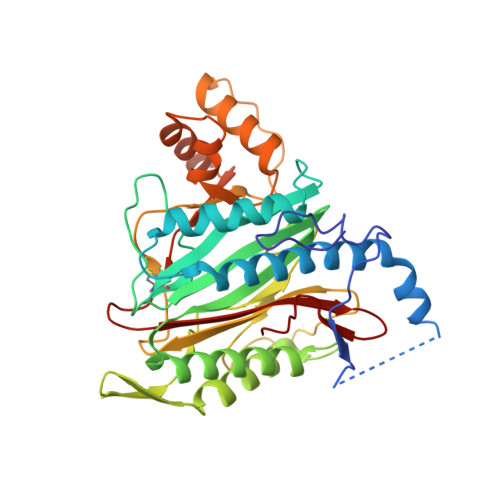Highly potent inhibitors of methionine aminopeptidase-2 based on a 1,2,4-triazole pharmacophore.
Marino, J.P., Fisher, P.W., Hofmann, G.A., Kirkpatrick, R.B., Janson, C.A., Johnson, R.K., Ma, C., Mattern, M., Meek, T.D., Ryan, M.D., Schulz, C., Smith, W.W., Tew, D.G., Tomazek, T.A., Veber, D.F., Xiong, W.C., Yamamoto, Y., Yamashita, K., Yang, G., Thompson, S.K.(2007) J Med Chem 50: 3777-3785
- PubMed: 17636946
- DOI: https://doi.org/10.1021/jm061182w
- Primary Citation of Related Structures:
2OAZ - PubMed Abstract:
High-throughput screening for inhibitors of the human metalloprotease, methionine aminopeptidase-2 (MetAP2), identified a potent class of 3-anilino-5-benzylthio-1,2,4-triazole compounds. Efficient array and interative synthesis of triazoles led to rapid SAR development around the aniline, benzylthio, and triazole moeities. Evaluation of these analogs in a human MetAP2 enzyme assay led to the identification of several inhibitors with potencies in the 50-100 picomolar range. The deleterious effects on inhibitor potency by methylation of the anilino-triazole nitrogens, as well as the X-ray crystal structure of triazole 102 bound in the active site of MetAP2, confirm the key interactions between the triazole nitrogens, the active site cobalt atoms, and the His-231 side-chain. The structure has also provided a rationale for interpreting SAR within the triazole series. Key aniline (2-isopropylphenyl) and sulfur substituents (furanylmethyl) identified in the SAR studies led to the identification of potent inhibitors (103 and 104) of endothelial cell proliferation. Triazoles 103 and 104 also exhibited dose-dependent activity in an aortic ring tissue model of angiogenesis highlighting the potential utility of MetAP2 inhibitors as anticancer agents.
- Department of Medicinal Chemistry, Enzymology, Oncology, and Structural Biology, GlaxoSmithkline, King of Prussia, PA 19406, USA. joseph.p.marino@gsk.com
Organizational Affiliation:


















